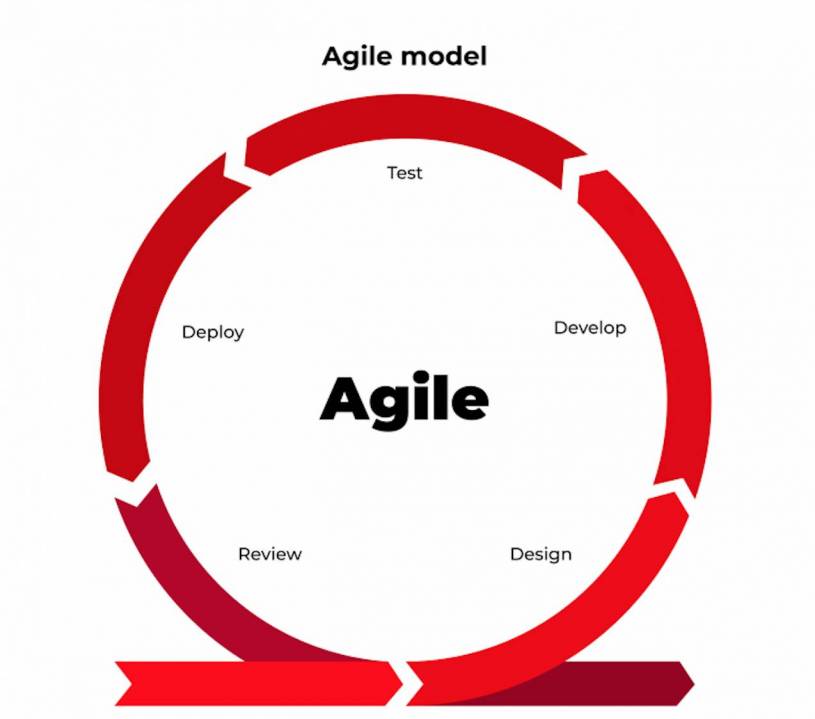The competitive, oversaturated market pushes companies to seek better ways to manage workload and optimize the working process to strive for continuous improvement and client satisfaction. At the same time, leaders are also looking towards acquiring that entrepreneur Agility. Thus, many have been fostering Agile thinking and mindset within their teams.
Agile mindset is a system of beliefs characterized by a customer-centric approach, emphasizing communication and consistent collaboration with the customer and inside the team. It is executed through practices of Kanban, Scrum, XP. The four Agile values, defined in the Agile Manifesto, deliver value to the customer, responsiveness to change, effective communication, and people centricity.
What is Agile Thinking?
Agile thinking is about embracing the philosophy of continuous change and growth over time. It’s more than just working by the Agile principles. It’s about achieving excellence: delivering maximum value and creating the best product possible based on the customer’s needs, responding to changes as the project progresses to achieve the final result envisioned by the client.
The primary objective of any project is client satisfaction. This can be achieved through relentless work and hundreds of hours put in by the team. But at some point, you have to look back and make sure that you not only work hard but work smart.
You can put in double the hours to complete a huge chunk of work, or you can optimize your process and deliver results faster.
You may work on a big project from start to finish and present it to the client, work in iterations, show some usable functionality at each step of the process, take in feedback, and adjust on the go.
In this day and age, when everything is moving fast, and change is inevitable, the latter is the preferable choice. More and more companies lean toward adopting agile culture into their team through its principles and behaviors.
Stop Starting, Start Finishing with Agile
The whole Agile culture might be clearly explained by the statement “Stop starting, start finishing” that lies in the methodology basis.
This notorious quote has been attributed to many individuals, but, originally it was used at a stand-up meeting in February of 2004 by David J. Anderson, the thought leader and the pioneer of the Kanban movement and CEO of Kanban University. The meaning behind it comes from one of the key ideas of Kanban, which is limiting the number of items in progress, preferably working on one task at a time.
Productivity may be a concern if you are working on multiple tasks simultaneously. That is why the focus should be on finishing tasks, one way of accomplishing which may be having fewer tasks “in progress.” You want to deliver tangible results, instead of piling up unfinished tasks and becoming overwhelmed with the sheer amount of work that needs to be completed, all within deadlines.
What are the Actionable Tips for “Stop Starting, Start Finishing?”
Or maybe you are a hardcore multitasker and cannot begin to imagine how this could be feasible? Here are some tips on how you can do this.
- Try not to have unfinished tasks migrate from Sprint to Sprint. Maximize the effectiveness of your Sprint planning and be realistic about your capacity.
- Don’t pile up WIP items. Having too many tasks in progress creates an elusiveness of being too busy and reduces overall productivity.
- Know how you spend your time. How much time it takes you to complete a task. This will help you improve planning and manage your time better. That way, you can achieve balance and maximum efficiency, reduce stress, and be a better version of yourself.
- Know your dependencies. If you can’t effectively finish tasks within a given time frame, this bears a burden on the entire team and even cross-team. Be mindful of the people who rely on you having finished the task on time.
- Be committed to finishing the tasks that you take up. Know what you can manage, and don’t bite off more than you can chew.
- Don’t bounce between unfinished tasks. This may mean that you are inefficient and not completing any tasks. Instead, it would be better to focus on one task at a time.
- Keep a zero inbox. Keep up effective communication with your team and the customer.
- Deliver acceptable results. Favor value over output. Your main objective is to deliver a useable product to the customer. Know what is expected and deliver results.
- Prioritize your tasks. Urgent and important tasks always come first!
- Teamwork and collaboration. It’s not only about working on individual tasks but what’s important is to assess if, as a team, we can collaborate towards completing a user story and how to improve this teamwork.
The point being, you should manage your time and workload better, improve prioritization of tasks, know what’s expected, and work as a team.
How to think “Agile.”
Applying Agile basics to your work routine may be an easy adjustment, but what presents a real challenge is to change the way you think, adjust your entire mindset. You may try to achieve this by creating appropriate conditions for improvement in your working environment.
Agile rests upon the three pillars of People, Processes, and Tools. Thereby derive the main principles to achieve organizational Agility:
- Define the purpose. Set your eyes on the goal and do whatever it takes to reach it. Team collaboration directed at completing a user-story takes priority over each individual to-do list, as it takes a team effort on all stages of the project cycle to create a useable product or piece of functionality.
- Visualize the scope of work. To assist this, teams use a Kanban board available in many management tools like Jira and the like. With a Kanban board, you can see the entire scope of work for the planned period of time and the status of each task.
- Embrace planning in all its forms. These are PI planning, sprint planning, daily stand-ups.
- Seek continuous improvement. Measure your performance, set goals, and plan ahead. Have regular checkpoints to see how well you are doing.
The Agile process model, as depicted in the image below, shows a single cycle of a project which comprises gathering the requirements, design stage, development, testing, deployment, and review.

Upon the completion of each cycle, the client might find that there are new requirements for the project. Thus, the iterative nature of the project allows remaining flexible to any changes that may arise and respond to the client’s feedback upon each step of the process. Embracing the change allows for the project to grow and improve over time.
Benefits of implementing Agile thinking
Implemented properly Agile approach brings substantial business values for companies who apply it comparing with those who don’t and with any other methodology. Among some of the essential Agile benefits that matter for businesses are:
Increased productivity
The team can deliver higher quality products fast. A minimum viable product is delivered at the end of every sprint.
Continuous growth and innovation
Agile is a “growth” mindset. Flexibility to immediate changes in requirements means that the project constantly improves. This is a great environment to embrace innovation in all its aspects. This applies both to the project, team performance and processes. Through regular reviews and feedback, each team member is encouraged to always learn and grow as a professional. The processes are consistently reviewed and adapted to the current needs to increase efficiency and productivity.
Customer satisfaction
Agile is characterized by increased customer engagement in the project. The customer has more of a say in what is being done and how. If any changes are required, they are accounted for and implemented in the next iteration of the project. The customers get exactly what they want.
Trust and transparency
Agile is all about trust in team and business operations generally. That’s why companies that are using this approach are considered to be more trusted to partner up with other businesses. A great deal of trust is built by transparency. The team and the client know exactly what’s going on at any given stage of the project. The team is committed to the cause, with everyone working towards reaching the final goal. Clarity helps avoid issues, delays, and costly errors.
Reduced risks
The Agile approach encourages the team to be flexible to changes and be responsive to new requirements that may arise. In fact, it’s encouraged to implement changes in the project as possible. This has proven to greatly reduce risks and associated costs.
Summing up
Having adopted Agile thinking as the primary foundation for the workplace philosophy allows companies to keep up with the demands of the market and stay on top of the competition.
Learning and applying the principles to everyday routines and activities makes up an Agile team that is goal-oriented and responsive to change with the sole focus on creating a high-quality product and bringing to life the idea envisioned by the client.
Top Image Credit: liza summer; pexels; thank you!
Try Out Productivity Tools We Are Using
Monday.com | Best Productivity and Management Tool | on Monday.com | |
Calendar.com | Best Calendar and Scheduling Tool | on Calendar.com | |
Later.com | Best Social Media Scheduling Tool | on Later.com | |
Todoist.com | Best Time Management Tool | on Todoist.com | |
Toggl.com | Best Value Tool | on Toggl.com | |
Trello.com | Best Overall Tool | on Trello.com |


















